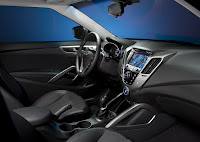Chevrolet displayed the all-new 2012 Sonic at the 2011 North American International Auto Show. Its youthful, aggressive design is backed by turbocharged performance and agile ride and handling, combining to deliver an efficient, fun-to-drive small car.
The Chevrolet Sonic is offered in two body styles: a stylish four-door sedan and a sporty five-door. Each delivers class-leading rear-seat roominess and cargo space. A variety of connectivity features enhance the driving experience.
Production of the Chevrolet Sonic begins later in 2011 at the General Motors Orion Assembly Center in Michigan, which received a $545-million investment in upgrades and retooling, and help restore approximately 1,000 jobs in the metropolitan Detroit area.
Progressive exterior design
From every angle, Chevrolet Sonic sedan and five-door models convey strength, stability and refinement. A wide, planted stance, with wheels-at-the-corners proportions, conveys performance. Progressive, raked body lines suggest movement even when the car is stationary.
Aggressive cues, including fender flares and motorcycle-inspired round headlamps, are blended with global design cues - a dual-element grille and round taillamps - for a design instantly recognizable as Chevrolet. The leading edge of the hood forms a character line above the headlamps, which flows in a sleek side profile characterized by uninterrupted body side lines, a high beltline and low roofline. The side mirrors carry the same shape as the car and seemingly disappear into the profile.
The sedan and five-door models are distinctively different. The five-door carries a tight, two-box shape with aggressive, diving feature lines, while the sedan's "notchback" profile has a more upscale and mature presence. At first glance, the five-door model looks like a three-door hatch because the rear door handles are discreetly located in the "C"-pillar area. The rear of the five-door continues with unconventional details, including exposed, motorcycle-inspired rear taillamps.
Details that reinforce Chevrolet Sonic's quality and attention to detail include chrome grille surrounds and matte black honeycomb grille inserts on all models, while a range of large wheel sizes, including 17-inch alloy wheels, reinforces its sporty demeanor.
Inspired interior
Chevrolet Sonic's cabin complements the motorcycle-inspired exterior with a detailed instrument cluster featuring a large, round analog tachometer set within an asymmetrical LCD readout, with a large digital speedometer display.
Additional interior highlights:
- The mid-instrument panel surface is available in two colors (dark titanium and brick) and flows seamlessly into the upper doors, with premium low-glass finishes
- The automatic shift knob has a "cobra head" design," while the manual shifter has a chrome-finished knob
- Tubular outboard climate outlets protrude from the instrument panel surface.
The interior includes storage compartments in the center stack and doors. The rear seats fold flat for carrying larger items. Front bucket seats are standard and heated front seats are available.
Cruze-based powertrains
Chevrolet Sonic models are powered by efficient, power-dense, small-displacement engines, including the Ecotec 1.4L turbo and the Ecotec 1.8L - the same engines used in the new Chevrolet Cruze. Three transmissions are available: a five-speed manual and six-speed automatic with the 1.8L and a six-speed manual with the 1.4L turbo.
The Ecotec 1.4L turbo's power ratings are estimated at 138 horsepower (103 kW) and 148 lb.-ft. of torque (200 Nm) between 1,850 rpm and 4,900 rpm. The wide rpm range for the maximum torque - a specific trait of turbocharged engines - helps the engine deliver a better driving experience and performance. Premium design elements give the engine world-class smoothness and durability. Features:
- Low-mass hollow-frame cast iron block
- Dual overhead camshafts with variable valve timing
- Chain-driven cams
- Roller-finger camshaft followers
- Piston-cooling oil jets and integrated oil cooler
- Variable-flow oil pump
- Electronically controlled thermostat.
The 1.4L's turbocharger is integrated within the exhaust manifold, for reduced weight and greater packaging flexibility in small vehicles. A reinforced crankshaft and stronger connecting rods deliver additional strength to support the engine's pressurized power and torque over a wide rpm band.
The naturally aspirated Ecotec 1.8L engine has many of the same features of the Ecotec 1.4L turbo. It is a compact and durable four-cylinder engine designed for low maintenance, low emissions and fuel efficiency. Its two-stage variable intake manifold allows approximately 90 percent of peak torque to be available from 2,400 rpm to 6,500 rpm. It is estimated at 135 horsepower (101 kW), along with 123 lb.-ft. of torque (167 Nm) at 3,800 rpm.
Engineered for agile, athletic ride and handling
The Chevrolet Sonic brings agility and a fun-to-drive feel that is rare in the segment. Engineers who also work on the Corvette tuned the Sonic's confident ride and handling, giving it a more direct and athletic feel, while balancing the vehicle for the broad range of driving conditions in North America.
All models feature a MacPherson strut front suspension with coil springs and stabilizer bar, and a semi-independent, torsion beam axle-mount compound link-type rear suspension - featuring a robust, tubular V-shape beam - with gas-charged shocks. The front and rear tracks are identical at 59.4 inches (1,509 mm), for well-planted stability and excellent balance.
Electronic power steering is standard and features a wear compensator that continually adjusts the system interaction with the steering gear to ensure precise steering action over the life of the system.
Chevrolet Sonic's body structure is designed to be one of the stiffest in the segment. Its rigidity enabled engineers to tune the ride and handling more precisely. Chevrolet Sonic's unique "flat top frame" cradle, for example, assures optimal stiffness in the front chassis portion of the vehicle. The rear axle is essentially a straight axle without contour for packaging restraints and reduced noise, vibration and harshness.
A range of wheel sizes is available, including 17-inch wheels and sport tires. Power-assisted front disc and rear drum brakes are standard, along with a four-channel antilock braking system. The four-sensor system - one at each wheel - incorporates electronic brake force distribution, which balances braking performance based on such factors as road conditions and the weight of passengers and/or cargo.






















































